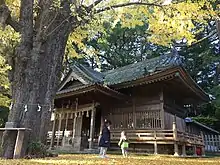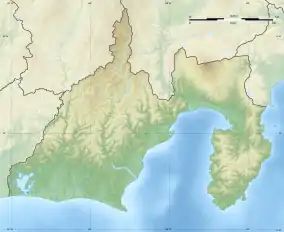| Kotonomama Hachiman-gū 事任八幡宮 | |
|---|---|
 Heiden of Kotonomama Hachiman-gū
| |
| Religion | |
| Affiliation | Shinto |
| Deity | Kotonomachi-hime no mikoto Hachiman |
| Festival | three days prior to Respect for the Aged Day in September |
| Location | |
| Location | 642 Yasaka, Kakegawa-shi, Shizuoka-ken 436-0004 |
 Shown within Shizuoka Prefecture  Kotonomama Hachiman-gū (Japan) | |
| Geographic coordinates | 34°47′54.20″N 138°04′31.54″E / 34.7983889°N 138.0754278°E |
| Architecture | |
| Founder | Emperor Seimu |
| Date established | c.Kofun period |
| Website | |
| Official website | |
Kotonomama Hachiman-gū (事任八幡宮) is a Shinto shrine located in the city of Kakegawa, Shizuoka Prefecture, Japan. It is one of two shrines claiming the title of ichinomiya of former Tōtōmi Province, the other being the Oguni Jinja in the town of Mori[1] The shrine's main festival is held annually three days prior to Respect for the Aged Day in September.[2]
Enshrined kami
The main kami at this shrine is Kotonomachi-hime no mikoto (己等乃麻知媛命), the mother of Ame-no-Koyane and the ancestor of the Nakatomi clan, and the Fujiwara clan. However, as the one of the shrine implies, the main focus of the shrine is on the Hachiman trinity, which at this shrine are identified as Empress Jingū, Emperor Ōjin and Tamayori-hime.[3]
History
The foundation date of this shrine is unknown. The shrine's legend states that it was established by the Mononobe clan, who were the Kuni no miyatsuko during the reign of the legendary Emperor Seimu (131-190 AD), but nothing is known of its history prior to its appearance in the Engishiki records in the early Heian period. The shrine also claims that it was originally located on Mount Hongu to the north of the present site, and was relocated in 807 by Sakanoue no Tamuramaro. As the worship of Hachiman spread in the late Heian period, Minamoto no Yoriyoshi had a bunrei of the Iwashimizu Hachiman Shrine installed at this shrine in 1062, which was thereafter referred to as the Nissaka Hachiman-gu (日坂八幡宮) or simply Hachiman-gu (八幡宮). It has been referred to as the ichinomiya of Tōtōmi Province since the early Kamakura period. As the shrine of located near Nissaka-shuku on the Tōkaidō highway near the location of the feared Nakayama Pass, one of the three major obstacles on the Tōkaidō, travelers would make prayers and offerings at this shrine. This is mentioned many times in literature, from Sei Shōnagon's The Pillow Book, the Azuma Kagami of the Kamakura period and the Jippensha Ikku's Tōkaidōchū Hizakurige of the Edo Period. It was restored by Tokugawa Ieyasu in 1603, who gave it estates worth 100 koku for its upkeep. Following the Meiji Restoration, it was given the rank Prefectural shrine under the Modern system of ranked Shinto Shrines. The ancient name of "Kotonomama" was only revived after the end of World War II.[4]
Gallery
 Second Torii
Second Torii Heiden
Heiden
See also
References
- ↑ "Nationwide List of Ichinomiya," p. 1.; retrieved 2011-08-010
- ↑ Shibuya, Nobuhiro (2015). Shokoku jinja Ichinomiya Ninomiya San'nomiya (in Japanese). Yamakawa shuppansha. ISBN 4634150867.
- ↑ Yoshiki, Emi (2007). Zenkoku `Ichinomiya' tettei gaido (in Japanese). PHP Institute. ISBN 4569669301.
- ↑ Okada, Shoji (2014). Taiyō no chizuchō 24 zenkoku `Ichinomiya' meguri (in Japanese). Heibonsha. ISBN 4582945619.